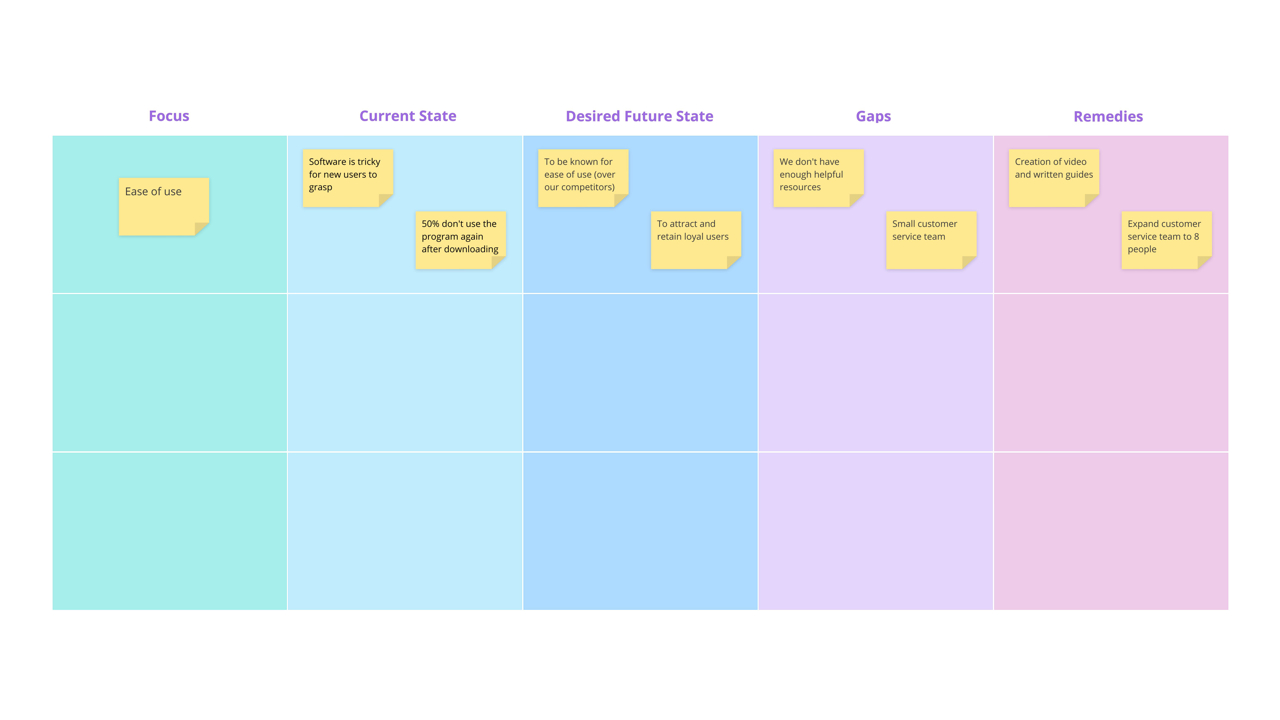Gap Analysis template

Ayoa’s Gap Analysis template will enable you to define your business’s goals by identifying what is missing from your processes, products and services, so you can begin to make improvements that will bring you a step closer to achieving these goals.
What is a gap analysis?
A gap analysis is a strategic tool that is used by managers to understand the difference between the current state of their organization, what they want this to be and how they can achieve this – particularly in regards to its financial situation. As the name suggests, a ‘gap’ analysis helps you to set achievable goals by identifying the gaps between your company’s ‘Current State’ and its ‘Desired Future State’ – whether this is in terms of an internal or external business process, or a product or service you offer to your customers. You can then use this information to define what improvements can be made to help you reach your goals.
A gap analysis will require you to use a combination of general assumptions and data to define your company’s current state and generate ideas of what you can do to bridge the gap between your current situation and where you want to be. Our Gap Analysis template has been designed to be used with your team to brainstorm as many solutions as possible and ensure that the best steps are being taken to help your business achieve success sooner.
Why should you use our Gap Analysis template?
A gap analysis is an effective strategic thinking tool for any manager that wants to encourage business growth and align their team’s goals. By identifying key challenges and opportunities faced by your business and clearly defining what you want to achieve and why, you can clarify your objectives as a team – which will allow you to work together to put a solid plan into action. This will help to keep everyone on the same page, as well as clearly focused on achieving the goals you defined together.
Our Gap Analysis template helps you to put information in a visual format, which will kickstart your creative thinking and help you to generate better ideas. By putting your company’s Current State and Desired Future State side-by-side, you can visualize solutions to bridge the gap and help your business to make improvements that will generate great results. You can also identify any obstacles that may be standing in the way of your growth as a company.
Our Gap Analysis template is set out in the format of a colorful collaborative whiteboard that is already organized into the sections you need to conduct your gap analysis. You can then add any information to the template using sticky notes – as if you were brainstorming ideas on a physical whiteboard!
How to use our Gap Analysis template
Our Gap Analysis template enables you to conduct a quick, yet effective analysis with your team and create a detailed plan of action. Ready to get started? Discover how to use the template in Ayoa below.
To access the template, sign up to Ayoa. Once you've signed up, navigate to the homepage to create a new whiteboard, mind map or task board and choose this template from the library.
Invite your team to the template so they can brainstorm ideas with you. When everyone has access to the board, you can then brainstorm together in person or over a video call.
Tip: Ayoa has a built-in video chat feature that is available for users with an Ultimate plan. This means that you and your team can have a virtual meeting and work together using the template at the same time, and in the same app!
FOCUS. In the first column of the template, use each of the boxes to define any areas you want to analyze. This could be related to your business’s processes, products or services, such as improving efficiency within the manufacturing process or making your product easier for your customers to use. Add one focus to each of the boxes using sticky notes.
CURRENT STATE. In regards to the first focus area you identified, describe what your company’s “current state” is. How is it performing in this area right now? What issues have arisen? What would you like to improve going forward? Discuss these questions with your team, using your own assumptions and any data you are able to access to help form your answers. Again, add your answers to the template using sticky notes.
DESIRED FUTURE STATE. In this section, use sticky notes to outline what you want the ‘current state’ of your business to evolve into in regards to the area you’re currently focusing on. Ask yourself: What does success look like to your business? What do your customers want? What are your competitors doing that is working well for them?
At this stage, it can be helpful to flip any issues you’ve already identified on their heads to help you actually determine what you want to achieve through this exercise.
GAPS. Now it’s time to spot the gaps between your ‘current state’ and ‘desired future state’. Essentially, what obstacles are standing in the way of you moving to your desired state? In terms of making a product (such as a piece of software) easier to use, the ‘gaps’ could be not having the resource to create tutorials and help guides for your customers to access – such as a lack of time or staff.
Where possible, try to add specific metrics. This will enable you to compare whether substantial improvements have been made in the future.
REMEDIES. Identifying the gaps between your ‘current state’ and ‘future desired state’ will lead you to being able to devise actionable solutions to the problems you’re facing as a business. In this section of the template, use sticky notes to add the tasks you and your team will carry out to bridge the gaps you’ve spotted and encourage growth. Remember to focus on tasks that will generate results you can easily measure, so you can quickly assess whether they are actually having an impact.
When determining the actions you’re going to take, try to keep your goals firmly in mind. This will help you to be more strategic in your planning and focus your team’s efforts on prioritizing tasks that are going to have the most impact.
Tip: Did you know? You can open up a task board within a whiteboard (such as the Gap Analysis template) in Ayoa. The categories of your task board will appear along the bottom of your whiteboard, where you can drag and drop your sticky notes into a category to turn them into tasks. You can then assign these tasks to others, set start dates, due dates and reminders, plus add notes, comments, attachments and more to keep yourself on track. Find out more in our guide to adding tasks to a whiteboard.
Work with your team to fill in each section for every focus area you’ve identified. If you want to explore more areas in detail, you can easily add more sections and sticky notes to the template using the menu on the left-hand side of the app.
